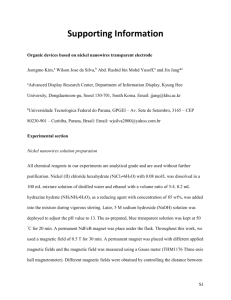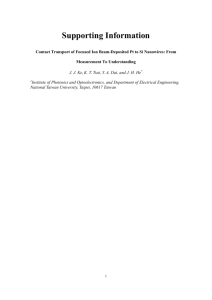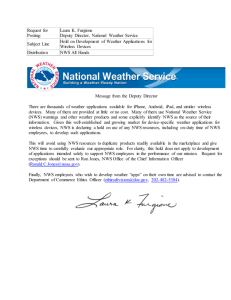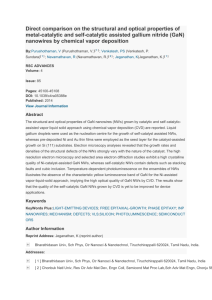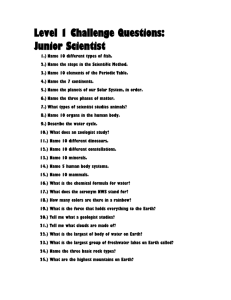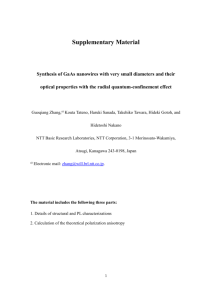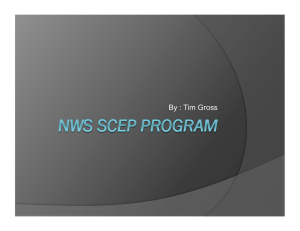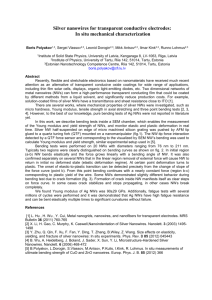Near-ideal theoretical strength in gold nanowires containing angstrom scale twins ARTICLE Jiangwei Wang
advertisement
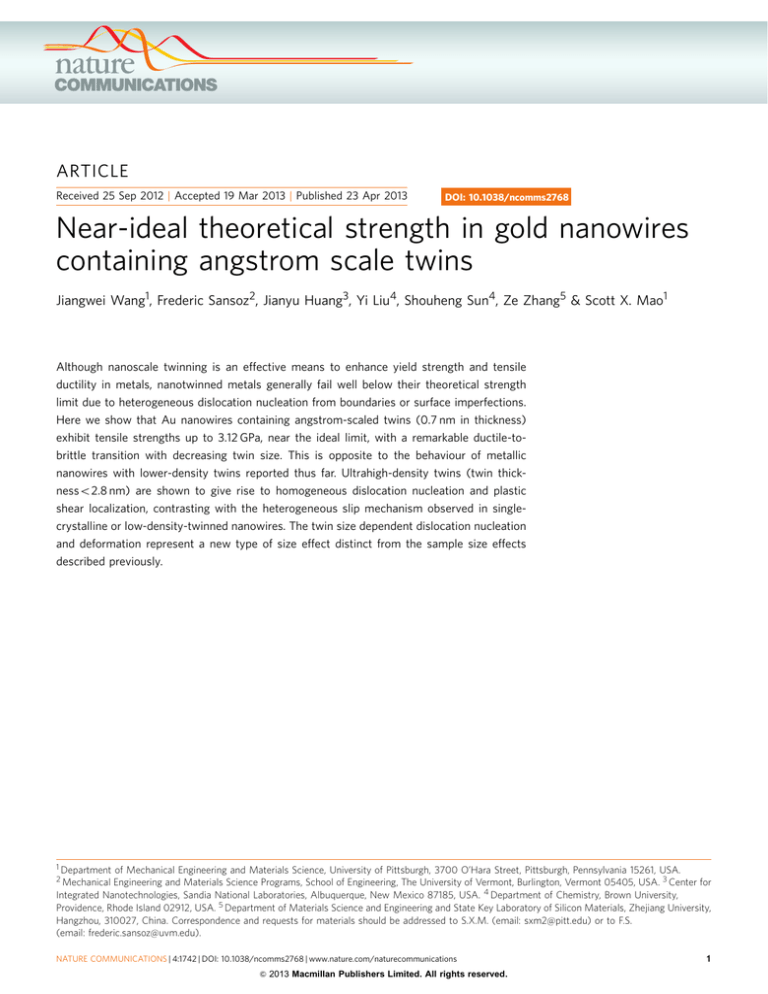
ARTICLE
Received 25 Sep 2012 | Accepted 19 Mar 2013 | Published 23 Apr 2013
DOI: 10.1038/ncomms2768
Near-ideal theoretical strength in gold nanowires
containing angstrom scale twins
Jiangwei Wang1, Frederic Sansoz2, Jianyu Huang3, Yi Liu4, Shouheng Sun4, Ze Zhang5 & Scott X. Mao1
Although nanoscale twinning is an effective means to enhance yield strength and tensile
ductility in metals, nanotwinned metals generally fail well below their theoretical strength
limit due to heterogeneous dislocation nucleation from boundaries or surface imperfections.
Here we show that Au nanowires containing angstrom-scaled twins (0.7 nm in thickness)
exhibit tensile strengths up to 3.12 GPa, near the ideal limit, with a remarkable ductile-tobrittle transition with decreasing twin size. This is opposite to the behaviour of metallic
nanowires with lower-density twins reported thus far. Ultrahigh-density twins (twin thicknesso2.8 nm) are shown to give rise to homogeneous dislocation nucleation and plastic
shear localization, contrasting with the heterogeneous slip mechanism observed in singlecrystalline or low-density-twinned nanowires. The twin size dependent dislocation nucleation
and deformation represent a new type of size effect distinct from the sample size effects
described previously.
1 Department
of Mechanical Engineering and Materials Science, University of Pittsburgh, 3700 O’Hara Street, Pittsburgh, Pennsylvania 15261, USA.
Engineering and Materials Science Programs, School of Engineering, The University of Vermont, Burlington, Vermont 05405, USA. 3 Center for
Integrated Nanotechnologies, Sandia National Laboratories, Albuquerque, New Mexico 87185, USA. 4 Department of Chemistry, Brown University,
Providence, Rhode Island 02912, USA. 5 Department of Materials Science and Engineering and State Key Laboratory of Silicon Materials, Zhejiang University,
Hangzhou, 310027, China. Correspondence and requests for materials should be addressed to S.X.M. (email: sxm2@pitt.edu) or to F.S.
(email: frederic.sansoz@uvm.edu).
2 Mechanical
NATURE COMMUNICATIONS | 4:1742 | DOI: 10.1038/ncomms2768 | www.nature.com/naturecommunications
& 2013 Macmillan Publishers Limited. All rights reserved.
1
ARTICLE
NATURE COMMUNICATIONS | DOI: 10.1038/ncomms2768
T
he device integration of Au nanowires (NWs) hinges upon
better understanding the ultrahigh strength1 and fracture
behaviour of individual NWs under nanoscale deformation
by direct measurements. As a model material, bulk Au is
intrinsically the most ductile and malleable metal with a tensile
ductility in the range of 0.2B0.4 (ref. 2). Past experimental
studies showed that Au NWs can be pulled with a strain up to
50% (ref. 3), and long atomic chains can be formed until the last
atomic bond breaks4. Recent experiments and molecular
dynamics (MD) simulations also showed that sub-10 nm-sized
Au single crystals possess very good ductility before fracture5,6.
However, it was also reported in another recent study that
ultrathin Au NWs can fail via brittle fracture with negligible
ductility7. Brittle failure was attributed to deformation twinning7,
whereas this mechanism is recognized as promoting superplastic
deformation in metallic NWs3,8,9. In view of these conflicting
observations, one question naturally arises: how to decisively
control fracture in metallic NWs?
The plastic deformation and fracture of bulk ultrafine-grained
metals containing nanoscale twins has been extensively studied
since first being observed 8 years ago10. It is now well-established
that nanotwinned face-centred-cubic (FCC) metals have superior
mechanical strength, remarkably high ductility, and better
tolerance to fatigue crack initiation with decreasing twin
thickness (l)11–13. Below a specific limit (lo15 nm), reducing
l dramatically enhances ductility due to softening effects,
attributed to heterogeneous nucleation and propagation of
partial dislocations at the intersection of pre-existing twin
boundaries (TBs) with grain boundaries (GBs)11,12,14. Likewise,
in FCC single-crystalline NWs without GBs, heterogeneous
nucleation of new partial dislocations from free surfaces is
prominent5,6,15. Moreover, introducing low-density twins (LDTs)
to single-crystalline NWs can give rise to extensive strainhardening and plastic flow after yielding, owing to the blockage of
partial slip by TBs5,15. However, the maximum strength achieved
in such materials is still considerably smaller than the ideal
strength, which theoretically refers to the stress at elastic
instability in a defect-free infinite crystal15. Furthermore,
although ultrahigh-density twins (UDTs) are frequently
observed in metallic NWs synthesized chemically16–18,
deformation and failure in NWs with growth UDTs remain
largely unexplored, specifically near the minimum limit of twin
size (that is l ¼ 0.7 nm).
Here we present a series of in-situ tensile tests on Au NWs with
UDTs conducted under transmission electron microscopy
(TEM)-atomic force microscopy (AFM), as well as a detailed
description of underlying mechanisms of deformation by highresolution TEM (HRTEM) combined with MD computer
simulations. We show that UDTs provoke a ductile-to-brittle
transition at a critical size (l ¼ 2.8 nm), controlled by homogeneous nucleation of dislocations inside the NWs followed by
shear localization and confined microplasticity at TBs. This new
regime turns ultrathin Au NWs into brittle-like materials with
near-ideal strength, and is unlike the heterogeneous nucleation of
partial slip from free surfaces that has commonly been reported
for Au NWs with no twins and LDTs.
Results
In-situ mechanical measurements in Au NWs. Figure 1 presents
the microstructure of ultra-twinned Au NWs as synthesized in
this study, along with mechanical properties of these materials
under pure tensile loading. The growth direction of Au NWs is
along o1114 (Fig. 1a), with the diameter between 8 and 20 nm.
Detailed TEM analysis reveals that parallel UDTs are perpendicular to the wire axis, and that the NW surface is made of {111}
2
microfacets (Fig. 1b). Supplementary Fig. S1 shows the twin
distributions in two types of Au NWs exhibiting distinct
mechanical behaviour. The first type represents NWs with UDTs,
in which l varies over a narrow range from three atomic layers
(l ¼ 0.7 nm) to B2 nm (Supplementary Fig. S1a). In the second
type, the NWs show a bimodal twin distribution with a mixture of
UDT and LDT spacings (Supplementary Fig. S1b). Also, we note
that slight departure from the o1104 zone axis could make
some of the UDTs invisible (Supplementary Fig. S2).
Figure 1c,d shows that the mechanical response of Au NWs
with UDTs differs markedly from that of Au NWs with LDTs and
no twins. The ultimate strength of Au NWs with no twins was
found equal to 1.43 GPa with no strain-hardening after yielding,
in excellent agreement with past experimental measurements in
pure single-crystalline Au NWs19. This value is 430 times higher
than the tensile strength of micrometre-thick polycrystalline Au
films, which is typical due to plasticity size effects20. The
mechanical response of Au NWs with LDTs is characterized by
significant strain-hardening with an ultimate strength of
B2.05 GPa after yielding (B1.7 GPa), as well as by a sizeable
ductility (B35%). Figure 1c shows that this behaviour contrasts
with that of Au NWs with UDTs where strain-hardening is found
to disappear, ductility is considerably reduced, and the elastic
limit increases to B3.12 GPa (Fig. 1c,d), which is much higher
than that of our Au NWs with LDTs and no twins (Fig. 1d)
and single-crystalline Au nanocrystals reported in the
literature2,3,19,21–26 (Fig. 1e). Remarkably, this limit corresponds to a critical resolved shear stress of 0.98 GPa for partial
{111}o1124 slip (Schmid factor ¼ 0.314), which is very close to
the ideal shear strength of 1.42 GPa for pure Au reported from
past first-principle calculations27. Moreover, the fracture
behaviour of Au NWs with UDTs is brittle-like with a flat
fracture surface perpendicular to the loading axis (Supplementary
Fig. S3a). Although the total elongation is about 7.2% due to the
high elastic strain, plastic elongation at failure is negligible
(o1%). In contrast, the behaviour of NWs with bimodal
structure appears to be semibrittle with slightly lower yield
strength (B2.1 GPa) and limited, but finite inelastic deformation
(B5%) and strain-hardening up to B2.52 GPa (Fig. 1c,d). For
both brittle and semibrittle fracture modes, no apparent plasticity
is observed away from the fracture zone, but an interesting feature
is that a tiny tip is formed on the failure surface in semibrittle
NWs only (Supplementary Fig. S3b).
Homogeneous dislocation nucleation and deformation. The
above results enable us to conclude that a sharp transition from
ductile plasticity to brittle fracture takes place in ultra-twinned
Au NWs with increasing twin density. The nature of the ductileto-brittle transition is further examined by in-situ HRTEM and
MD computer simulations. First, we consider the deformation
and fracture of Au NWs with LDTs and no twins. Figure 2a–c
and Supplementary Fig. S4 confirm that the deformation of Au
NWs with LDTs and no twins is dominated by dislocations
nucleated from free surfaces5,6,15. In the Au NWs with LDTs,
uniform plastic elongation followed by necking primarily occurs
between TBs with the largest l (Supplementary Fig. S4a–c and
Supplementary Movie 1). TBs are also found to act as barriers for
partial dislocation motion (Fig. 2b,c), thus contributing to the
observed strengthening and strain-hardening effects5,11,15.
Interestingly, stacking faults (SFs) nucleated on different {111}
planes interact to form SF cross-structures (Fig. 2d), which
coincides well with the SF structure shown in Fig. 2f when a NW
with l ¼ 5.6 nm and a uniform twin distribution is strained in
tension by MD simulation. Similarly, the MD simulations show
extensive plastic deformation mediated by partial dislocations
NATURE COMMUNICATIONS | 4:1742 | DOI: 10.1038/ncomms2768 | www.nature.com/naturecommunications
& 2013 Macmillan Publishers Limited. All rights reserved.
ARTICLE
NATURE COMMUNICATIONS | DOI: 10.1038/ncomms2768
TB
2.2
Brittle
3.0
UDTs
Bimodal
Semibrittle
Twins
2.0
LDTs
2.5
Engineering stress (GPa)
(111)
[111]
1.8
No twins
1.6
2.0
Bimodal
LDTs
1.4
Ductile
1.5
2 3 4 5 6 7 8
Ductile
1.0
0.5
{111} Surface facets
0.0
0
5
10
15
20
25
30
35
40
Engineering strain (%)
3.5
Present work, [111] NWs:
UDTs
Bimodal
LDTs
No twins
3.5
UDTs: Brittle
3.0
2.5
Bimodal: SemiBrittle
LDTs: Ductile
2.0
1.5
No twins: Ductile
1.0
Ultimate strength (GPa)
Ultimate strength (GPa)
3.0
2.5
2.0
1.5
Other works:
[111] NWs, T (Ref.19)
[111] Nanopillars, C (Ref.21)
[110] NWs, T (Ref.3)
[110] Nanowhiskers, T (Ref.22)
[100] Nanopillars, T (Ref.2)
[100] Nanopillars, C (Ref.2)
[100] Nanopillars, C (Ref.23)
[100] Nanopillars, C (Ref.24)
[100] Nanopillars on MgO, C (Ref.25)
Au Nanopillars, C (Ref.26)
1.0
0.5
0.5
Bulk Au
0.0
8
10
12
14
16
18
20
Bulk Au
0.0
0
200
400
Diameter (nm)
600
800
1,000
1,200
Diameter (nm)
Figure 1 | Microstructure and mechanical properties of ultra-twinned Au NWs. (a) Morphology of as-synthesized Au NW. Scale bar, 10 nm.
(b) High-resolution TEM (HRTEM) image of the yellow-boxed area in a shows UDTs distributed along the NW axis ranging from three atomic layers
(0.7 nm) to a few nanometres. {111} microfaceting can also be observed at the free surface. Scale bar, 2 nm. (c) Representative stress–strain curves for Au
NWs with different structures obtained by in-situ TEM–AFM experiments. Dash lines in pink colour indicate the permanent inelastic deformation after
fracture. The diameter of samples with either UDTs or bimodal structures are almost identical, 14.5 and 13.4 nm respectively. The inset shows a close-up
view of the yield points in the specimens with bimodal and LDTs. (d) Strength distribution in Au NWs with different fracture modes tested in this study.
(e) Comparison of ultimate strengths in Au nanocrystals deformed by tension (T) or compression (C) experiments. The flow stress at 10% strain
is used as the ultimate strength of compression tests on nanopillars.
with SFs nucleated from the surface (Fig. 2e,f), uniform
elongation between two TBs (Supplementary Movie 2), and
typical ductile stress–strain curves (Supplementary Fig. S5) when
l is as small as 5.6 nm.
The fracture of a brittle-like NW with UDTs is displayed in
Fig. 3 for comparison. In this example, the twin thickness l is less
than 2.1 nm with a predominance of twins at the minimum limit
of 0.7 nm (Supplementary Fig. S1a). Under tension, the NW first
experiences considerable elastic elongation as evidenced by the
space increase between TB3 and TB4 in Fig. 3b, but sudden failure
occurs at an applied strain of 6.8% (Fig. 3c–e and Supplementary
Movie 3). The fracture process is materialized over such a short
timescale that rare dislocation activity is observed, which is at
odds with the larger slip deformation and ductility observed in
single-crystalline twin-free Au NWs3,6 and Au NWs with LDTs.
However, the grains formed in the fractured tips (Fig. 3d,e)
indicate that significant slip and de-twinning have occurred in the
confined zone separating TB1 and TB4. This result is further
supported by the MD simulations where a net reduction in
ductility and shift to brittle-like fracture are manifest in NWs
with a {111}-microfaceted surface structure and lr2.8 nm
(Supplementary Fig. S5), although the ductile-to-brittle
transition seems less pronounced if NWs are modelled with a
perfectly circular shape (Supplementary Fig. S6). Moreover, the
simulated fracture is contained within a short NW segment
exhibiting significant de-twinning (Fig. 3f,g) as in the TEM
experiments. A salient feature in MD simulations is that the onset
of yielding in brittle-like NWs proves to be controlled by
homogeneous nucleation of dislocations between TBs (Fig. 3h), as
opposed to heterogeneous deformation from free surfaces
(Fig. 2a–c).
We examine the local shear strains computed at atomic-level
from MD simulations to gain insight into the relationship
between homogeneous nucleation, the de-twinning process and
brittle-like fracture. Here, particular focus is placed on an ultratwinned Au NW with l ¼ 1.4 nm and a {111} microfaceted
morphology (Fig. 4 and Supplementary Movie 4). At the yield
point, nucleation of dislocation loops on different slip planes is
solely found inside the crystal (Fig. 4a,b). Notably the nucleation
sites are primarily adjacent to surface facets (see inset of Fig. 4b).
At this stage of deformation, the average shear strain at a
nucleation site is equal to 0.136±0.011, which agrees well with
the ideal shear strain of 0.142 found theoretically by ab-initio
simulations27 for {111}o1124 slip in Au. It can also be noticed
NATURE COMMUNICATIONS | 4:1742 | DOI: 10.1038/ncomms2768 | www.nature.com/naturecommunications
& 2013 Macmillan Publishers Limited. All rights reserved.
3
ARTICLE
NATURE COMMUNICATIONS | DOI: 10.1038/ncomms2768
TB
TB
SF
SF
SF
98 s
116 s
98.5 s
30% strain
= 5.6 nm
Figure 2 | Heterogeneous dislocation nucleation in Au NWs with LDTs (k45.6 nm). (a) TEM image of an Au NW with LDTs. TBs are marked out by a
dash line in yellow colour. Scale bar, 5 nm. (b,c) During tensile loading, partial dislocations with SFs nucleate heterogeneously from the free surface,
propagate and are blocked by the TBs, as marked out by the red arrows. Scale bar, 5 nm. (d) Interaction of surface dislocations on different {111} slip planes
to form SF cross-structures from a different NW with lB10 nm. Scale bar, 1 nm. (e) Full atomistic view and (f) cross-sectional view of a NW with uniform
twin distribution and l ¼ 5.6 nm at 30% tensile strain as modelled by MD simulation. The colour coding corresponds to surface atoms in yellow colour,
atoms in TBs and SFs in red colour, and atoms in perfect FCC crystal arrangement in grey colour.
1 23 4
= 1.4 nm
0s
123 4
35 s
1
4
35.5 s
Figure 3 | Tensile deformation and fracture in brittle-like Au NWs with UDTs (ko2.8 nm). (a) TEM image of a pristine Au NW showing UDTs ranging
from 0.7–2.1 nm, viewed in [110] zone axis. Twin interfaces of interest in the fracture zone are marked as TB1—TB4. Scale bar, 10 nm. (b) Under tensile
loading, the NW experiences elastic elongation as evidenced by the increase in spacing between TB3 and TB4. Scale bar, 10 nm. (c) At the elastic strain of
6.8%, the Au NW breaks suddenly with a relatively flat fracture surface, typically encountered in brittle fracture. Scale bar, 10 nm. (d,e) Post-deformation
fracture morphology of Au NWs at the two ends. A large de-twinned grain is found at both ends. Scale bar, 5 nm. (f) Full atomistic view and (g) crosssectional view of Au NW with uniform twin distribution and l ¼ 1.4 nm after fracture at 5.5% tensile strain by MD simulation. (h) Close-up view of the
fracture region at the onset of yielding showing the homogeneous nucleation of dislocations indicated by vertical arrows, near surface facets but inside the
NW. Atoms in perfect FCC crystal arrangement have been omitted for clarity.
that the yield strength of 5.5 GPa for o1114 tension
(Supplementary Fig. S5) is generally higher than in
experiments, which can be attributed to the strain rate effects
4
inherent to MD simulations, the interatomic potential used, and
the uncertainty in NW shape (see MD simulations method).
However, it can be concluded that the yield strength of Au NWs
NATURE COMMUNICATIONS | 4:1742 | DOI: 10.1038/ncomms2768 | www.nature.com/naturecommunications
& 2013 Macmillan Publishers Limited. All rights reserved.
ARTICLE
Homogeneous
nucleation
NATURE COMMUNICATIONS | DOI: 10.1038/ncomms2768
0.11
0.15
Shear
localization +
De-twinning
De-twinning
Fracture
Shear localization
0
0.5
Shear strain
Figure 4 | Simulated deformation structure and shear strain in a brittle-like Au NW over the yielding process. The Au NW contains UDTs with
l ¼ 1.4 nm and {111} surface microfacets. (a,b) Homogenous nucleation, 5.2% strain. (c,d) Plastic shear localization and de-twinning, 5.6% tensile strain.
(e,f) Fracture above 5.75% strain.
with UDTs rises up to the ideal strength limit, thereby making
homogeneous dislocation nucleation the rate-limiting process
controlling fracture. As discussed later, we hypothesize that
homogeneous nucleation in ultra-twinned Au NWs is induced by
an instability comparable to that only found in perfect FCC
crystals subjected to nanoindentation or shock loading28,29.
Homogeneous dislocation nucleation is rapidly followed by
shear localization and specimen necking, which are both
accommodated by twin migration and de-twinning (Fig. 4d and
Supplementary Fig. S7). Here de-twinning arises from the atomic
ledges formed at neighbouring TBs during homogeneous
nucleation, and the shear localization when dislocations
transmit through the TBs (Fig. 4c–f). While de-twinning
promotes softening14 and can partly enhance ductile plasticity,
shear localization and necking accelerate the state of instability,
which may partly explain the occurrence of both de-twinned tips
and limited elongation in ultra-twinned Au NWs (Fig. 4e,f).
Figure 4c,d also suggests that the absence of work-hardening in
NWs with UDTs is related to the lack of dislocation blockage by
TBs5 and dislocation storage. The simulated fracture of a brittlelike NW with l ¼ 0.7 nm (Supplementary Fig. S7 and
Supplementary Movie 5) further reveals that the local UDTs
become largely unstructured in the fracture zone due to
significant shear localization-induced necking, which confirms
that this deformation mechanism becomes increasingly more
important over de-twinning, as l decreases to the minimum limit.
Semibrittle fracture in Au NWs with bimodal twin structures.
A striking aspect is the strong dependence of fracture on l in
ultra-twinned Au NWs. Remarkably, ultra-twinned Au NWs with
bimodal twin structures show a compromise between strength
due to homogeneous slip, and some microplasticity via de-twinning and strain-hardening, leading to the semibrittle fracture
(Fig. 1c). Further TEM evidence is shown in Fig. 5 where TBs of
interest in the fracture zone are marked out in yellow colour. It is
noticed that l is not uniform along the axial direction in this
specimen (Fig. 5a), and follows a bimodal twin distribution
(Supplementary Fig. S1b). In Fig. 5b, plastic deformation starts
in the region with the largest l (between TB3 and TB7 with
l B2.4–3.3 nm) in good agreement with past theoretical
predictions30. As described above, dislocations and SFs are
observed to nucleate directly inside the crystal (Fig. 5b); however,
several partial dislocations are blocked by TBs (TB3 and TB6 in
Fig. 5b), which likely contributes to the apparent strain-hardening
of the bimodal sample (Fig. 1c). Twinning partials causing
de-twinning (shown in white reversed ‘T’ at TB3 in Fig. 5b and
TB2 in Supplementary Fig. S8) are clearly visible because the
Schmid factor for this type of slip is extremely low due to the TB
orientation orthogonal to the NW axis. As deformation proceeds,
shear localization promotes necking formation at the free surface
(marked out with red-colour arrows in Fig. 5c) after limited
uniform plasticity. Propagation of SFs parallel to the twin plane
accompanies necking (Fig. 5c and Supplementary Fig. S8), and
appears to soften the material in this region until failure. Also a
tiny tip is visible in the fracture zone as a footprint of
post-yielding plasticity from de-twinning (Fig. 5d).
Discussion
This study provides strong evidence for a heterogeneous-tohomogeneous dislocation nucleation in ultra-twinned Au NWs
below a critical twin size (lr2.8 nm). As significant slip activity
was observed before failure, yielding in Au NWs with UDTs
should be viewed at the atomic scale as being different from
classical brittle fracture by atomic cleavage31. With UDTs, slip is
confined in such a way that the elastic strain energy cannot be
easily released by means of dislocation propagation6. Instead,
homogeneous dislocation nucleation multiplies primarily near
low-index surface facets, such as {111} microfacets, causing an
avalanche of new dislocations that accelerates shear localization and
necking. Therefore, Au NWs with bimodal twin structures show a
composite behaviour between ultimate strength and a few percent
of ductility, within a relatively narrow twin size distribution. In this
case, the local increase in l provides enough volume for dislocations
to propagate and interact with neighbouring TBs in other areas of
the NW, thereby explaining the emergence of strain-hardening and
ductility via de-twinning5,15.
Surprisingly, the ductile-to-brittle transition promoted by the
heterogeneous-to-homogeneous dislocation nucleation with
NATURE COMMUNICATIONS | 4:1742 | DOI: 10.1038/ncomms2768 | www.nature.com/naturecommunications
& 2013 Macmillan Publishers Limited. All rights reserved.
5
ARTICLE
NATURE COMMUNICATIONS | DOI: 10.1038/ncomms2768
12 3
4 5
6
7
123
4
SF
0s
62 s
SF
σ
1 23
4 5 SF 6
7
1
Twin
51 s
158 s
Figure 5 | Deformation and fracture in a semibrittle Au NWs with bimodal twin structures. (a) Pristine Au NW with a bimodal twin structure as marked
out by dash lines in yellow from TB1 to TB7. (b) As deformation proceeds, dislocations are observed to homogeneously nucleate in the segment with the
largest twin thickness. The dislocations propagate and are blocked by the neighbouring TBs, causing strain-hardening. (c) Shear localization-induced
necking formation under tensile loading, as marked out by the red arrows. Inset: Close-up on a partial dislocation with SF propagating along the radial
direction from the neck, which softens this region and accelerates failure. (d) Fracture morphology of semibrittle fracture with de-twinned tips. Main scale
bar, 5 nm; Inset scale bar in c, 1 nm.
increasing twin densities, is totally opposite to the change from
brittle fracture to ductile plasticity reported so far in nanotwinned
ultrafine-grained Cu materials11, and recent experiments on
single-crystalline Cu nanopillars and NWs with ultrathin
twins18,32. The ultrafine-grained Cu containing nanotwins
exhibits increasing softening and ductility with decreasing
l11,12, because deformation mediated by GBs are typically
responsible for a transition from brittle fracture to extended
ductility with decreasing l12. Recent experiments on
nanotwinned Cu nanopillars without GBs32 have shown a
brittle-to-ductile transition in samples loaded perpendicularly to
TBs, as the TB spacing decreases below a critical value (B34 nm), in which the deformation was found to be dominated by
the heterogeneous nucleation of dislocations from the
intersections of TBs with the free surface. The brittle-to-ductile
transition resulted from such heterogeneous nucleation of
dislocations from the TBs/surface intersections, and shear band
formation propagating across the samples32.
This distinctive behaviour can possibly be understood by
considering three factors. First, the stacking-fault energy curve
being different between metals33, the stresses required to nucleate
new dislocations from both heterogeneous and homogeneous
nucleation is 2–3 times larger in Cu than Au34. However, the
tensile strength previously measured in 50-nm nanotwinned Cu
nanopillars (1.35 GPa)32 is twice as small as that of our ultratwinned Au at a comparable twin size (l ¼ 1.4 nm), which is
indicative that the deformation mechanisms in Cu nanopillars
with ultrathin twins are not related to homogeneous dislocation
nucleation like Au NWs with UDTs. Second, the diameter of Au
NWs in this study is the smallest ever reported in the literature
for metallic NWs with UDTs. Past theoretical studies have shown
that TBs exert a repulsive force on gliding dislocations due to
6
image effects across the interface30,35. Such repulsive force
increases linearly with 1/l, and the slope of this linear
relationship was found to double with decreasing NW diameter
from 25 to 8 nm (refs 30,36). Brittle-like fracture may therefore
occur in ultra-twinned Au NWs with lr2.8 nm because the
theoretical strength limit is likely more rapidly attained than in
larger NWs. This assumption is also supported by the fact that
only softening due to heterogeneous dislocation nucleation from
the TB-surface intersection was found in larger Cu nanopillars
with ultrathin twins32. Third, the ideal strength limit in a metal
has been shown to be dictated by instabilities in the acoustic
phonon spectra37. In semiconductor crystalline NWs, phonon
spectra and vibrational behaviour can be markedly influenced by
the type of surface facets, such as {111} microfacets38. Surface
effects on homogeneous dislocation nucleation are also manifest
from our MD simulations (Supplementary Fig. S6). Furthermore,
past atomistic studies in circular metallic NWs have shown that
the TB-surface intersections may have the largest atom vibration
and higher stress concentration36,39. In metallic NWs, however,
surface effects remain largely unexplored, primarily because
characterizing the details of the surface structure at the atomic
scale is extremely challenging experimentally. Nevertheless, the
fact that ultra-twinned NWs in Cu and Au have been synthesized
by different methods suggests that these NWs may have different
surface structures and, therefore, different mechanical behaviour
with increasing twin density.
In conclusion, we report direct quantitative measurements on
individual, ultrathin Au NWs with UDTs by in-situ tensile testing
inside a TEM. These findings shed lights on a new regime of
fracture in metallic NWs, and its physical mechanism, which can
be controlled by modulating twin densities and therefore
represents a new type of size effect distinct from sample size
NATURE COMMUNICATIONS | 4:1742 | DOI: 10.1038/ncomms2768 | www.nature.com/naturecommunications
& 2013 Macmillan Publishers Limited. All rights reserved.
ARTICLE
NATURE COMMUNICATIONS | DOI: 10.1038/ncomms2768
effects described previously. Furthermore, the conclusions of this
study demonstrate the possibility of fabricating gold nanostructures with a desirable combination of ultrahigh strength and some
ductility through optimization of the twin structure, which is of
technological importance for micro-devices subjected to extreme
stresses.
Methods
In-situ experiments. Two types of experiment were conducted. First, the
Nanofactory TEM-scanning tunneling microscope (STM) platform with an AFM
cantilever (App. Nano Inc.) serving as a force sensor was used to measure the
stress–strain curves of Au NWs. The spring constant (k) of the cantilever was
calibrated as 28 N m 1. Then, a Nanofactory TEM-STM platform with a STM
probe was used to study the deformation mechanism under in-situ HRTEM. All
experiments were carried out inside a FEI Tecnai F30 field emission gun TEM. The
NWs were attached to a piezo-controlled STM probe and then driven to approach
the cantilever or the other STM probe. Finally, they were welded together by
amorphous carbon deposition at the contact area via the illumination of low
intensity electron beam. Subsequently, the NW was pulled back. The real-time
images of sample elongation and the deflection (Dd) of cantilever were recorded by
a CCD (charge-coupled device) camera at two frames per second. The tensile
loading force (F) was directly calculated by timing the deflection Dd by its spring
constant k. The engineering stress was calculated by using the formula, s ¼ 4F=pd2
where d is the NW diameter, and assuming that the NWs have a quasi-circular
cross-section. The engineering strain was calculated by measuring the real-time
length of the NWs from TEM images. More details on the in-situ experimental setup can be found in our previous study6.
Materials. The synthesis of Au NWs was based on the method described in Wang
et al. 40 Eighteen millilitres oleylamine (OAm) was heated to 60 °C under gentle
N2 flow. In another container, 44 mg HAuCl4xH2O was dissolved in a mixture of
0.2 ml OAm and 2 ml hexane. The HAuCl4xH2O solution was injected into the
60 °C OAm and held at the same temperature for 15 h without any disturbance
such as magnetic stirring. After cooling to room temperature, 10 ml ethanol was
added to precipitate the Au NWs. Au NWs with varied diameters can be made
from different synthesis temperatures. Supplementary Fig. S9 shows the
representative morphology of as-synthesized Au NWs with UDTs. Typically, the
diameter of Au NWs presented in our study was uniform along the axial direction.
Also, some variations in diameter were only observed at the two ends of the NWs.
HRTEM study shows that the Au NWs are highly twinned (Fig. 1a,b). However,
some of the high-density TBs in the TEM images will be invisible if the view zone
slightly deviates from the [110] zone axis (Supplementary Fig. S2). Au NWs were
tilted to the [110] zone axis before tensile testing for the in-situ HRTEM study.
Tensile loading was applied along the NW axis in the o1114 direction until
failure. For the TEM–AFM study, only Au NWs with uniform diameter and clean
surface were chosen for the mechanical test. The NW ends were ‘glued’ to the AFM
cantilever, and, therefore, did not significantly contribute to the deformation and
strength measurements. Furthermore, all samples failing near the NW ends have
been excluded in the mechanical data and fracture analysis. More than 20 samples
were tested and about 40% were found to break with a brittle-like fracture. Au
NWs with LDTs and no twins were created inside the TEM by using the cold
welding technique.
MD simulations. MD simulations were performed using the software LAMMPS41
with an embedded-atom-method potential for Au by Grochola et al.42 We note
that this potential was developed to simulate the growth and morphology of Au
nanoparticles based on first-principles calculations, and, therefore, accurately
predicts the SF and surface energies of this metal. Twelve realizations with uniform
UDTs using different periodic lengths (68 and 270 nm), different twin densities
(0.7rlr5.6 nm) and different surface structures (perfectly circular and {111}
microfaceted morphologies) were performed. [111]-oriented, periodically twinned
NWs with a uniform l were constructed by stacking platelet-like grains with a
truncated octahedral shape made only by {111} surface facets. Owing to UDTs, this
type of structure produced smooth sidewalls with atomic facets similar to those
observed in experiments in Fig. 1b. Cylindrical NWs with same l were also
modelled with a circular cross-section in order to characterize the effect of surface
morphology. Each twin plane was perpendicular to the NW axis, that is [111]
crystallographic direction. Periodic boundary conditions were imposed along the
NW axial direction, while the sides were kept free in all other directions. The
diameter and periodic length were equal to 12 and 68 nm, respectively, for all wires.
The time step was 2 fs. Before deformation, each model was relaxed for 40 ps under
zero pressure using an isothermal–isobaric (constant number of particles N,
constant pressure P, constant temperature T) ensemble with a Nose-Hoover
thermostat at 300±2 K. Temperature was rescaled after 500 steps. The NW was
deformed in tension by stretching the simulation box along the [111] direction at a
constant engineering strain rate of 1 108 s 1 in the canonical (constant N,
constant volume V, constant T) ensemble at the same temperature. Atomic-level
snapshots of NW deformation were studied using the bond angle analysis and the
local shear strain calculation in the atomic visualization software Ovito43. The
Virial theorem and deformed atomic volume were used to calculate the axial stress
in the NWs. Stress–strain calculations were based on the periodic lengths and
average diameter, and did not take into account the local deformation due to
necking. Error in strain calculations was limited because the simulations were
performed at a constant engineering strain rate. However, caution was exercised in
dealing with the stress values obtained after the onset of necking. In particular,
deformations in brittle-like NWs were mostly elastic except for a localized plastic
zone, as opposed to the behaviour of ductile NWs. It is, therefore, possible that
larger elastic energy was released during fracture with the longer NWs,
contributing to the length effect observed in Supplementary Fig. S5.
Moreover, it is noticed that the strength (5.5 GPa) of NWs with UDTs predicted
in simulations is higher than in experiments. The strain rate effects inherent to MD
simulations could be a factor. Another reason is that the interatomic potential used
in our simulations could largely overestimates the ideal strength of {111}o1124
slip in Au (1.73 GPa) compared with more accurate ab-initio simulations
(1.42 GPa) (ref. 27). Also, the NW shape could influence the maximum stress
predicted in MD simulation (Supplementary Fig. S6). The {111} surface microfacets
is revealed in Fig. 1b, but it could not be used to fully comprehend the threedimensional shape of the NWs. So stress predictions from simulations could also
be overestimated because very idealized models have been used. Thus, the ideal
strength of 5.5 GPa predicted by our MD simulations should be viewed as an upper
limit for the ideal strength of o1114-oriented Au crystals.
References
1. Zhu, T. & Li, J. Ultra-strength materials. Prog. Mater Sci. 55, 710–757 (2010).
2. Kim, J. -Y. & Greer, J. R. Tensile and compressive behavior of gold and
molybdenum single crystals at the nano-scale. Acta. Mater. 57, 5245–5253
(2009).
3. Seo, J. -H. et al. Superplastic deformation of defect-free au nanowires via
coherent twin propagation. Nano. Lett. 11, 3499–3502 (2011).
4. Lagos, M., Sato, F., Galvão, D. & Ugarte, D. Mechanical deformation of
nanoscale metal rods: when size and shape matter. Phys. Rev. Lett. 106, 055501
(2011).
5. Deng, C. & Sansoz, F. Enabling ultrahigh plastic flow and work hardening in
twinned gold nanowires. Nano. Lett. 9, 1517–1522 (2009).
6. Zheng, H. et al. Discrete plasticity in sub-10-nm-sized gold crystals. Nat.
Commun. 1, 144 (2010).
7. Lu, Y., Song, J., Huang, J. Y. & Lou, J. Fracture of sub-20nm ultrathin gold
nanowires. Adv. Funct. Mater. 21, 3982–3989 (2011).
8. Park, H., Gall, K. & Zimmerman, J. Deformation of FCC nanowires by
twinning and slip. J. Mech. Phys. Solids 54, 1862–1881 (2006).
9. Park, H. & Ji, C. On the thermomechanical deformation of silver shape
memory nanowires. Acta. Mater. 54, 2645–2654 (2006).
10. Lu, L., Shen, Y. F., Chen, X. H., Qian, L. H. & Lu, K. Ultrahigh strength and
high electrical conductivity in copper. Science 304, 422–426 (2004).
11. Lu, L., Chen, X., Huang, X. & Lu, K. Revealing the maximum strength in
nanotwinned copper. Science 323, 607–610 (2009).
12. Li, X., Wei, Y., Lu, L., Lu, K. & Gao, H. Dislocation nucleation governed
softening and maximum strength in nano-twinned metals. Nature 464,
877–880 (2010).
13. Zhang, Z. J., Zhang, P., Li, L. L. & Zhang, Z. F. Fatigue cracking at twin
boundaries: effects of crystallographic orientation and stacking fault energy.
Acta. Mater. 60, 3113–3127 (2012).
14. Zhu, T. & Gao, H. [Plastic deformation mechanism in nanotwinned metals: an
insight from molecular dynamics and mechanistic modeling]. Scripta
Materialia 66, 843–848 (2012).
15. Deng, C. & Sansoz, F. Near-ideal strength in gold nanowires achieved through
microstructural design. ACS Nano. 3, 3001–3008 (2009).
16. Bernardi, M., Raja, S. N. & Lim, S. K. Nanotwinned gold nanowires obtained by
chemical synthesis. Nanotechnology 21, 285607 (2010).
17. Hong, X., Wang, D. & Li, Y. Kinked gold nanowires and their SPR/SERS
properties. Chem. Commun. 47, 9909–9911 (2011).
18. Zhong, S. et al. Nanoscale twinned copper nanowire formation by direct
electrodeposition. Small 5, 2265–2270 (2009).
19. Lu, Y., Song, J., Huang, J. & Lou, J. Surface dislocation nucleation mediated
deformation and ultrahigh strength in sub-10-nm gold nanowires. Nano. Res. 4,
1–7 (2011).
20. Espinosa, H. D., Prorok, B. C. & Peng, B. Plasticity size effects in free-standing
submicron polycrystalline FCC films subjected to pure tension. J. Mech. Phys.
Solids 52, 667–689 (2004).
21. Budiman, A. S. et al. A search for evidence of strain gradient hardening in Au
submicron pillars under uniaxial compression using synchrotron X-ray
microdiffraction. Acta. Mater. 56, 602–608 (2008).
22. Sedlmayr, A. et al. Existence of two twinning-mediated plastic deformation
modes in Au nanowhiskers. Acta. Mater. 60, 3985–3993 (2012).
23. Greer, J. & Nix, W. Nanoscale gold pillars strengthened through dislocation
starvation. Phys. Rev. B 73, 245410 (2006).
NATURE COMMUNICATIONS | 4:1742 | DOI: 10.1038/ncomms2768 | www.nature.com/naturecommunications
& 2013 Macmillan Publishers Limited. All rights reserved.
7
ARTICLE
NATURE COMMUNICATIONS | DOI: 10.1038/ncomms2768
24. Greer, J., Oliver, W. & Nix, W. Size dependence of mechanical properties of
gold at the micron scale in the absence of strain gradients. Acta. Mater. 53,
1821–1830 (2005).
25. Lee, S. -W., Han, S. M. & Nix, W. D. Uniaxial compression of fcc Au
nanopillars on an MgO substrate: the effects of prestraining and annealing.
Acta. Mater. 57, 4404–4415 (2009).
26. Volkert, C. A. & Lilleodden, E. T. Size effects in the deformation of sub-micron
Au columns. Philosophical Magazine 86, 5567–5579 (2006).
27. Ogata, S., Li, J., Hirosaki, N., Shibutani, Y. & Yip, S. Ideal shear strain of metals
and ceramics. Phys. Rev. B 70, 104104 (2004).
28. Gouldstone, A., Van Vliet, K. J. & Suresh, S. Nanoindentation: Simulation of
defect nucleation in a crystal. Nature 411, 656–656 (2001).
29. Norman, G. E. & Yanilkin, A. V. Homogeneous nucleation of dislocations. Phys
Solid State 53, 1614–1619 (2011).
30. Deng, C. & Sansoz, F. Repulsive force of twin boundary on curved dislocations
and its role on the yielding of twinned nanowires. Scripta Materialia 63, 50–53
(2010).
31. Meyers, M. A. & Chawla, K. K. Mechanical Behavior of Materials. 2nd edn
(Cambridge University Press, 2009).
32. Jang, D., Li, X., Gao, H. & Greer, J. R. Deformation mechanisms in
nanotwinned metal nanopillars. Nat. Nanotechnol. 7, 594–601 (2012).
33. Van Swygenhoven, H., Derlet, P. M. & Froseth, A. G. Stacking fault energies
and slip in nanocrystalline metals. Nat. Mater. 3, 399–403 (2004).
34. Deng, C. & Sansoz, F. Fundamental differences in the plasticity of periodically
twinned nanowires in Au, Ag, Al, Cu, Pb and Ni. Acta. Mater. 57, 6090–6101
(2009).
35. Chen, Z., Jin, Z. & Gao, H. Repulsive force between screw dislocation and
coherent twin boundary in aluminum and copper. Phys. Rev. B 75, 212104
(2007).
36. Deng, C. & Sansoz, F. Size-dependent yield stress in twinned gold nanowires
mediated by site-specific surface dislocation emission. Appl. Phys. Lett. 95,
091914 (2009).
37. Clatterbuck, D. M., Krenn, C. R., Cohen, M. L. & Morris, Jr J. W. Phonon
instabilities and the ideal strength of aluminum. Phys. Rev. Lett. 91, 135501
(2003).
38. Sansoz, F. Surface faceting dependence of thermal transport in silicon
nanowires. Nano. Lett. 11, 5378–5382 (2011).
39. Zhang, Y. & Huang, H. Do twin boundaries always strengthen metal
nanowires? Nanoscale Res. Lett. 4, 34–38 (2008).
40. Wang, C., Hu, Y., Lieber, C. M. & Sun, S. Ultrathin Au nanowires and their
transport properties. J. Am. Chem. Soc. 130, 8902–8903 (2008).
8
41. Plimpton, S. Fast parallel algorithms for short-range molecular dynamics.
J. Comput. Phys. 117, 1–19 (1995).
42. Grochola, G., Russo, S. P. & Snook, I. K. On fitting a gold embedded atom
method potential using the force matching method. J. Chem. Phys. 123, 204719
(2005).
43. Stukowski, A. Visualization and analysis of atomistic simulation data with
OVITO–the Open Visualization Tool. Modelling Simul Mater. Sci. Eng. 18,
015012 (2010).
Acknowledgements
S.X.M. acknowledges NSF CMMI 08 010934 through University of Pittsburgh and
Sandia National Lab support. F.S. thanks support from NSF CAREER programme (Grant
DMR-0747658), and the computational resources of the Vermont Advanced Computing
Center (NASA Grant NNX06AC88G). This work was performed, in part, at the Center
for Integrated Nanotechnologies, a US Department of Energy, Office of Basic Energy
Sciences user facility. Sandia National Laboratories is a multi-programme laboratory
operated by Sandia Corporation, a wholly owned subsidiary of Lockheed Martin Corporation, for the US Department of Energy’s National Nuclear Security Administration
under contract DE-AC04-94AL85000. This research was supported in part by an
appointment to the Sandia National Laboratories Truman Fellowship in National
Security Science and Engineering sponsored by Sandia Corporation.
Author contributions
J.W.W. carried out the TEM experiments under the direction of S.X.M. and J.H. J.H.,
S.X.M. and Z.Z. created the experimental protocols. F.S. performed the computer
simulations and theoretical analysis. Y.L. and S.H.S. provided the samples. All the
authors contributed to the discussion of the results. J.W.W., F.S. and S.X.M. wrote the
manuscript.
Additional information
Supplementary Information accompanies this paper at http://www.nature.com/
naturecommunications
Competing financial interests: The authors declare no competing financial interests.
Reprints and permission information is available online at http://npg.nature.com/
reprintsandpermissions/
How to cite this article: Wang, J. et al. Near-ideal theoretical strength in gold nanowires
containing angstrom scale twins. Nat. Commun. 4:1742 doi: 10.1038/ncomms2768
(2013).
NATURE COMMUNICATIONS | 4:1742 | DOI: 10.1038/ncomms2768 | www.nature.com/naturecommunications
& 2013 Macmillan Publishers Limited. All rights reserved.
